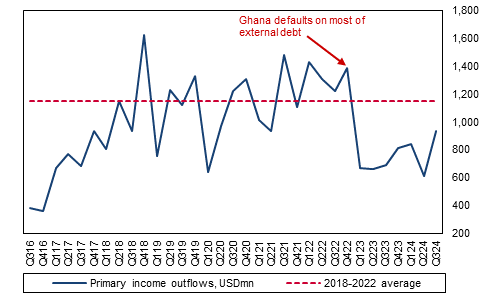Fitch Solutions has projected that Ghana’s primary income deficit will remain modest by historical standards, following the country’s successful debt restructuring efforts.
The restructuring agreement with commercial creditors has replaced previous dollar bonds with new instruments, effectively reducing Ghana’s external debt service obligations by $3.5 billion over the period 2024-2026.
According to Fitch Solutions, these adjustments have already led to a reduction in interest payments by 1.3% of GDP in 2024, with further reductions of 0.9% of GDP in 2025 and 0.6% in 2026 compared to the original bond terms.
Additionally, the agreement with official creditors has secured a moratorium on debt servicing until May 2026. As a result, the firm forecasts Ghana’s primary income deficit to remain contained at 3.1% of GDP, significantly lower than the five-year pre-default average of 5.5%.
Despite these improvements, Ghana’s current account is expected to face pressures due to reductions in US international aid. Over the past decade, donor assistance has been a key source of foreign exchange, with aid inflows accounting for nearly 50% of net current transfers.
The US, which contributes about a fifth of Ghana’s total aid receipts, recently announced a 90% cut in USAID contracts, a move expected to negatively impact the country’s secondary income surplus.
Although Fitch Solutions anticipates an increase in remittance inflows and aid from other donor countries, these are unlikely to fully offset the sharp decline in US aid. Consequently, the firm projects a 3.0% contraction in net current transfers in 2025.
The mixed outlook underscores the importance of Ghana’s fiscal adjustments and the need to diversify external funding sources to mitigate the impact of declining international aid inflows. Source: Norvanreport







